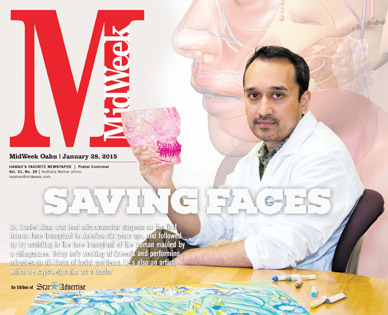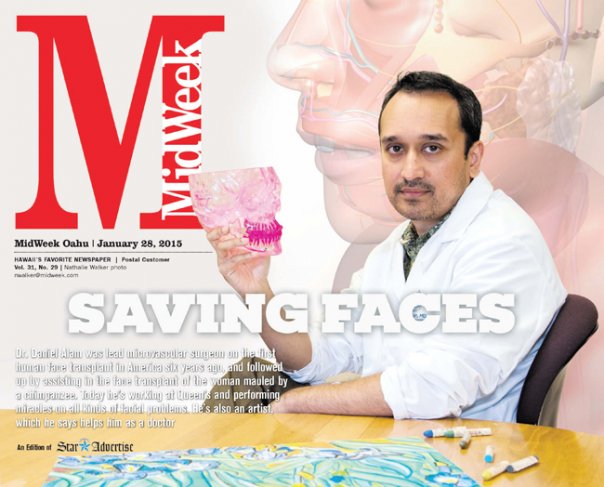Saving Faces
“It was really miraculous. It looked like a face again, within seconds.”
A combination of facial exercises and the body’s amazing healing ability allowed Culp to regenerate nerves, so that her brain began communicating with her new face, meaning she could again eat, breathe, regain a sense of smell, smile, laugh and talk. But more important, she was no longer just a mass of unsightly flesh. She was again able to interact with her family and rejoin the social world.
mw-cover-012815-2
Dr. Daniel Alam was lead microvascular surgeon on the first human face transplant in America six years ago, and followed up by assisting in the face transplant of the woman mauled by a chimpanzee. Today he's working at Queen's and performing miracles on all kinds of facial problems. He's also an artist, which he says helps him as a doctor | Nathalie Walker photo nwalker@midweek.com
Soon after operating on Culp, Alam encountered Charla Nash, whose case grabbed world headlines when a friend’s pet chimpanzee mangled her face. Alam again put his skills to work as part of her surgical team.
“We never know the value of our face because none of us have lived a single day without it,” he says with pause, letting the thought sink in. “When you actually spend 10 minutes in a room with these patients, you realize … they’re so disfigured that they really want the surgery for appearance. When you’re missing a face, you can’t have friends, you can’t have family. You can’t socialize. Connie can eat and breathe again, but what she really cares about is that she can have a normal relationship with her grandchild now.”
The word that comes to mind when you see the disfigured faces of the world’s 28 or so transplants is “monster.” Alam has met seven of them in person, and he says that’s the exact word they’ve each used to describe themselves.
“There’s an element of facial disfiguration where it’s a problem of the observer,” says Alam. “These people don’t stay at home because they want to be at home. They stay at home because society has blocked them out. Our brains see their faces and interpret danger. We see them as monsters. When we do reconstructive surgery on these patients, they don’t want to look beautiful, they just want to look human.”
Considering such devastating psychosocial repercussions, Alam says his favorite memory from these major transplant cases is highlighted in a simple picture of Culp and her boyfriend celebrating Christmas with him and his family. It’s a heartwarming conclusion to a tragic situation.
Facial transplant patients, it must be noted, face a lifetime of life-threatening, immunosuppressant medications so that their body’s natural defense mechanisms won’t reject the transplanted tissue. The story of a Chinese facial transplant patient who died after quitting his drugs, choosing to rely only on homeopathic medicine, is a cautionary tale. Therefore, a major psychiatric evaluation goes into any potential transplant case to be sure the patient will be attentive to the demanding post-op care. Alam’s advice was sought after the infamous face-eating “zombie” attack in Miami, and he quickly pointed out that the victim’s mental health history precluded him as a viable transplant candidate.
Cases as severe as Culp’s and Nash’s continue to be rare and experimental, not only because of ethical considerations, but also because of the exorbitant cost of the operation. Plus, when people are injured that badly, they generally don’t survive.
“It’s never going to be a cosmetic, ‘I don’t like my face, I want to do it over’ situation. Or (it won’t be) like the John Travolta, Nicolas Cage film (Face/Off) — I committed a few crimes, I asked the doctor to change my face so I can be somebody else,” says Alam. “It’s going to be somebody with a severe disfigurement, which basically is rare.”
While face transplants are the most dramatic instances of what can be done with facial surgery these days, Alam is making just as striking a difference in the lives of people in Hawaii on a daily basis through complex facial reconstruction. Rather than taking a face and planting it onto someone else, along with all of the associated moral and medical considerations, he is able to repair damaged skeletal and facial tissue with healthy counterparts in the person’s arm, leg or elsewhere. These kinds of surgeries have promising outcomes because there’s no need for immunosuppressant drugs, and therefore no lifelong medical regimen. Thanks to technological advancements and Alam’s own surgical inventions, his operations are ever more intricate and precise, focusing on tiny muscles and fragments of bone that he pieces together. That detailed reconstructive work inherently demands even more creativity and talent than a transplant.
One thing that informs his work, something he’s always been attracted to, is art. Alam colors attractive oil pastels in his free time, which he says give him insight and nuance when it comes to physically shaping areas of people’s faces, which are the true canvas for his creativity. Transplanting a fully formed face requires medical expertise, but it doesn’t benefit from the artistic touch that his ongoing work does.
The technical challenges of reconstructive surgery mixed with the field’s dynamic and growing possibilities were what got the Johns Hopkins med student to switch from heart surgery to plastic and microvascular surgery back in the early ’90s, when microvascular reconstruction was in its infancy. After a residency at Harvard and fellowship at UCLA, he joined the Cleveland Clinic for 12 years, where all of his breakthrough work took place, including the development of several new surgical procedures involved in intricate facial reconstruction and the treatment of facial paralysis. Many of the current generation of microvascular surgeons were Alam’s proteges, and he now is passing his knowledge on to students as a professor at John A. Burns School of Medicine, as well.
During his time at Harvard, Alam and his fellow residents decided they wanted collectively to make an ongoing difference not just at home, but in the world. Thus began their multi-annual medical missions to Guatemala, the Philippines, Peru, Ecuador and Rwanda, which they continue to do today — and have signed on new medical students as well. Alam’s expertise on the five-day trips is cleft lips. It’s a fairly simple surgery that makes such a difference for the families of all 25 patients he manages to operate on during the trip. And for travel purposes, the tools needed all fit in a compact kit, smaller than a lunchbox.
According to Alam, there’s still plenty of potential for facial reconstructive surgery. For instance, starting within the past 10 years, a CAT scan printed in 3-D now allows surgeons a tangible view of any facial skeletal abnormalities in a patient. One day 3-D printers may change the paradigm of reconstruction by engineering tissue ― using a person’s own biological material to, say, print a new ear, rather than grafting one from a person’s rib cartilage, as can be done currently. This type of marriage between technology and reconstruction could one day end the controversial elements of transplants by making the reliance on donor tissue and immunosuppression obsolete.
A preoccupation with the evolving refinement in facial reconstructive surgery methods combined with a desire to help people has placed Alam as a global forerunner in the field. He grew the field at Cleveland Clinic, and now he’ll be doing the same here in Hawaii.
“I still keep the Cleveland weather app,” he says, peeking at his phone and adding with a chuckle, “It’s 43 degrees there today, which reminds me that I’m in Hawaii! And I get to continue doing what I love to do.”
For more information on The Queen’s Head and Neck Institute, go to queensmedicalcenter.org/head-neck-institute or call 691-7215.







